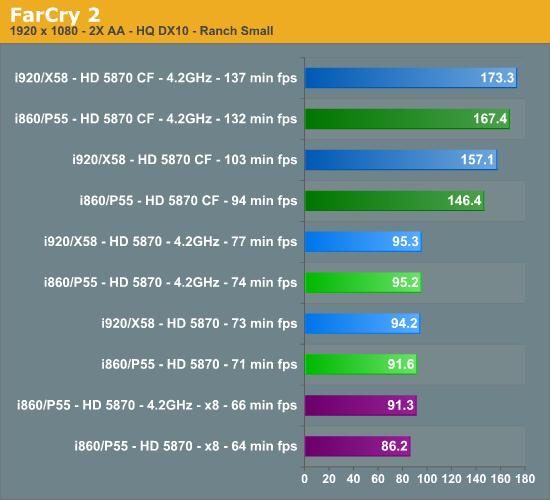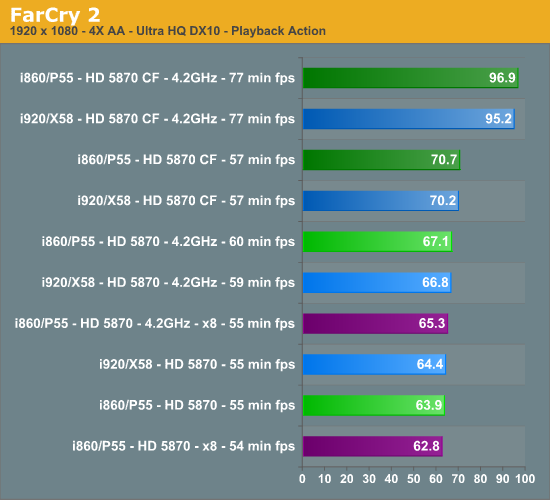ATI HD 5870 Scaling Performance: X58 vs P55 Showdown
by Gary Key on September 29, 2009 12:00 PM EST- Posted in
- Motherboards
FarCry 2
We utilize the Ranch Small demo file along with the Playback Action demo to see the differences between GPU and CPU centric benchmarks. The Ranch demo is GPU centric while the Playback demo tends to be CPU centric. We run each benchmark five times and report the median score.

First off, FarCry 2 has always performed extremely well on the X58 chipset compared to other chipsets with the ATI video cards. This game responds very well to PCIe bandwidth, something the X58 has in droves. The stock HD 5870 single card x8 configuration is 6% slower in average frame rates and 10% slower in minimum frame rates in this particular benchmark. Even the 4.2GHz single card result is slower than either the stock P55 or X58 setups.
The stock single card HD 5870 P55 platform is 3% slower than the X58 even with a 100MHz processor advantage in turbo mode. At 4.2GHz, both platforms are about even although minimum frame rates are about 4% better on X58. However, even with this benchmark advantage, there was no difference in actual game play, especially considering minimum frame rates are above 70fps in each instance.

The P55 results improve slightly as we move to a more CPU centric benchmark. The stock HD 5870 single card x8 configuration is only 2% slower in average frame rates and only 1% in the overclocked results. Comparing single card results between the P55 and X58, we see a 2% difference in favor of the X58 at stock speeds while at 4.2GHz the P55 finishes slightly ahead of the X58.
The pertinent data for CrossFire scaling is in the tables below. What we are looking for is the percentage speedup going from one to two HD 5870s on X58 and P55. In theory, X58 should have improved percentages because each GPU gets 16 PCIe 2.0 lanes while Lynnfield only provides 8 PCIe 2.0 lanes per GPU.
FarCry 2 CrossFire Scaling – Average Frame Rates
| ATI HD 5870 CF Scaling | FarCry 2 – Ranch Small | FarCry 2 – Playback Action | FarCry 2 – Ranch Small 4.2GHz | FarCry 2 – Playback 4.2GHz |
| Intel Core i7 920 (X58) | 66.8% | 9% | 81.8% | 42.5% |
| Intel Core i7 860 (P55) | 59.8% | 10.6% | 75.8% | 44.4% |
Based on our single card results, there are not a lot of surprises here. At stock speeds, the X58 has a 7% scaling advantage over the P55 and 6% when overclocked in the GPU centric Ranch demo. In the Playback Action benchmark, the results favor the P55 by almost 2%.
FarCry 2 CrossFire Scaling – Minimum Frame Rates
| ATI HD 5870 CF Scaling | FarCry 2 – Ranch Small | FarCry 2 – Playback Action | FarCry 2 – Ranch Small 4.2GHz | FarCry 2 – Playback 4.2GHz |
| Intel Core i7 920 (X58) | 41.1% | 3.6% | 77.9% | 30.5% |
| Intel Core i7 860 (P55) | 32.4% | 3.6% | 78.4% | 28.3% |
Minimum frame rates and scaling heavily favor the X58 in our stock clock speed results using the Ranch demo. Although frame rates still favor the X58 in this demo when overclocked, the scaling on the P55 is slightly better. The stock results in the Playback Action demo are a dead heat with a 2% advantage to the X58 when overclocked.
When it came to actual game play, there were no differences between either platform in the game. In fact, it was very difficult to discern which system was being utilized. The key giveaway was the foot warming heat coming from our case with the X58 overclocked. Our ambient temperature in the test room rose 2.1C over the course of testing with the X58 installed compared to 0.7C with the P55.










85 Comments
View All Comments
Dudlington - Wednesday, September 30, 2009 - link
I've still never seen this answered in any reviews:If P55 only has 16 PCI-E lanes, does that mean it is impossible to have 2 GFX cards (2x8 lanes) AND have a 1X or 4X expansion card? E.g., RAID, USB/Firewire, TV Tuner etc...?
Kind of a big deal to have not been brought up yet.
Scheme - Wednesday, September 30, 2009 - link
The 16 PCIe lanes you refer to are on the CPU (Lynnfield). The P55 chipset adds another 8 PCIe lanes for expansion cards.Dudlington - Wednesday, September 30, 2009 - link
Ahh - thank you very much. I've been wondering this for a while. I thought all PICe had been moved to the CPU.silverblue - Thursday, October 1, 2009 - link
If it had, then perhaps TA would have a point as regards Lynnfield being "brain-damaged" :) Hell, I'd probably pipe up and say it was a bad decision had they gone that particular route.Lynnfield is certainly attractive.
shaggart5446 - Wednesday, September 30, 2009 - link
can u use possible tripple ram in the linfield p55 platformstrikeback03 - Wednesday, September 30, 2009 - link
No, dual channel only. There was a Gigabyte motherboard with 6 RAM slots, but still dual-channel.vshin - Wednesday, September 30, 2009 - link
The X58 is a dead-end money pit. Gulftown will probably debut at $1k and will be out of reach for the majority of us so touting the 1366 platform as a good investment is bad advice. After the 920, Bloomfield offers little in return for the relatively high cost. TA is hoping to wait for Gulftown prices to fall under $300 but he should just give up. Look at Bloomfield... it's been out for a year and Intel would rather bump clock speeds to maintain prices rather than drop them. What makes TA think Gulftown will drop $700 before Sandy Bridge is out? It's a fool's hope.TA is right about one thing though. There is a missing 32nm segment between Gulftown and Clarkdale, which is what the budget enthusiast PC gamer is waiting for: 4-core 32nm Nehalem for under $300 without on-board graphics and no plans to SLI. Intel has been silent but everything points to a 32nm die-shrink of Lynnfield some time in mid-2010 to replace the current Lynnfield lineup at the same prices. This will be a drop-in upgrade for the 1156 socket so that actually makes the p55 platform a better deal for the near future.
If you have to upgrade right now, you can find 750/1156 combos for around $300, which is a good deal. You can overclock this system and it should hold you over till Sandy Bridge. If Intel does come out with a 32nm shrink, then you have the option to drop it in for an upgrade.
bobskeeper - Wednesday, September 30, 2009 - link
"The X58 is a dead-end money pit. Gulftown will probably debut at $1k and will be out of reach for the majority of us so touting the 1366 platform as a good investment is bad advice. After the 920, Bloomfield offers little in return for the relatively high cost. TA is hoping to wait for Gulftown prices to fall under $300 but he should just give up. Look at Bloomfield... it's been out for a year and Intel would rather bump clock speeds to maintain prices rather than drop them. What makes TA think Gulftown will drop $700 before Sandy Bridge is out? It's a fool's hope."I really don't know why you take every opportunity to assert that X58 is a "dead-end money pit" and that Gulftown is destined to be nothing more than a $1000+ boutique part. Such an assumption runs contrary not only to common sense but historical precedence. The best comparison would be the transition from the 65nm Kentsfield to the 45nm Yorkfield two years ago. It's true that the first Die-shrunk Yorkfield (The QX9650) did debut at the $1000 price point at the end of 2007. It was soon followed, however, by many other SKUs in early 2008 that hit the same price points that Intel has always liked to occupy, all the way down to $266 for the launch of the Q9300.
Intel knows the volumes on its most expensive parts are very low, which is why it arranges its launches in this manner; start with low-volume, high-cost parts as the new production process matures, then quickly follow with higher volume, higher value parts as yields and supply ramp up. There's no reason to believe that the transition from 45nm to 32nm will follow a different pattern. Gulftown will probably debut as an "Extreme Edition" part or whatever Intel is calling them these days, but it won't be long before more valuable models are introduced in the $300-500 price range. The only possible motivation Intel would have for keeping prices above $1000 would be a complete lack of competition from AMD. Thankfully, AMD is in a much better competitive position with Intel now (at least with regards to value if not bleeding-edge performace) than they were when Yorkfield debuted.
I guess the only real wrinkle is that technically Gulftown appears to be intended as a workstation/server part. (Hence the -town codename as opposed to the -field code names of previous consumer quad-cores.) Still, there tends to be just as much segmentation and pricing differential among current-gen Harpertowns, so again I'm not seeing any reason it will be any different with Gulftown.
vshin - Wednesday, September 30, 2009 - link
I actually do like Bloomfield and consider it better than Lynnfield from a technical standpoint. In fact, I would love nothing more than for Intel to release <$300 versions of Gulftown at launch but we both know that probably won't happen. But unlike TA, I won't try to spread bad advice. For the mainstream gamer, Gulftown will not be a reasonable upgrade path and that's the main reason why I can't recommend the X58 platform to this segment.The analogy you mentioned doesn't really apply since Intel has made it clear they want the p55 platform to occupy the "performance mainstream" market and reserve the X58 for the "extreme high-end" segment along with its higher pricing. It is much more likely they would shrink Lynnfield to 32nm than let i7 parts cannibalize the i5 lineup. In fact, you are seeing it already with Bloomfields maintaining the exact same price structure since release... even after one year. I wouldn't be suprised if Intel phases out i7 920 production very soon.
strikeback03 - Wednesday, September 30, 2009 - link
Given that Intel knows their sales numbers on the $1000+ processors, I wouldn't be surprised to see a ~$500-600 Gulftown at launch. Which is more than most of us are willing to pay, but if you are already considering $500+ in video cards, a processor in that range might not be bad either if the games can use it. Either way, I don't think you constantly calling X58 a dead-end money pit is any different than TA152H calling Lynnfield brain-damaged, both are exaggerations.I also wouldn't be too surprised to see the 920 disappear, but only because it doesn't separate itself from the Lynnfields by much. Now that they have Lynnfield to fill that price bracket, they can position X58 further upmarket. Considering Intel has generally not dropped new stuff on the market that was not on the public roadmap (such as a 32nm Lynnfield) I would guess the rumors are more a result of wishful thinking than concrete information. Maybe Sandy Bridge will be released earlier in the year to absorb 32nm capacity. I'd guess the Bloomfield pricing never moved much because there wasn't competition to bring it down. The X58 motherboards dropped with competition, but when the only competition to the 920 is the 860 and 870 and Intel prices them all accordingly, prices don't move.